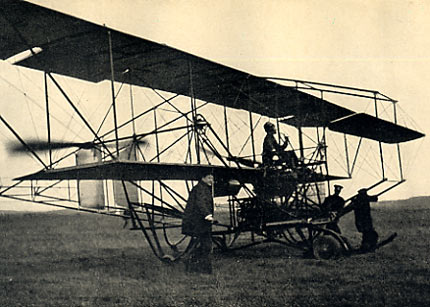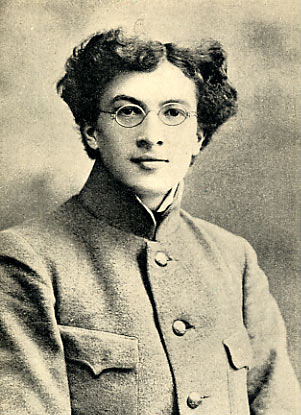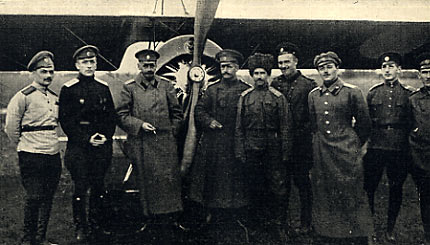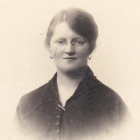People are always telling me that there is no way that you can find your Irish roots because all the records are lost. This article can help your search.

- A Scotman in Russia
- The First Steps
- Russian Military Flying Schools
- The Imperial All Russia Aero Club
- General Baron Kulbars & Aviation
- The Imperial Russian Technical Society
- The Prototype of the Zeppelin
- Contruction, Aviators & Workmen
- Famous Russian Flying Men
- I.I. Sikorsky
- Foriegn Aviators in Russia
- Heir Fokker's Russian Lady Pilot
- Just Before the War
- Aerial Russia & the British Press
- Aviation & the Russian Press
- By Way of Conclusion

Chapter IX - Famous Russian Flying Men
Mr. Segno was the first aviator to fly a German aeroplane in Russia. He was a pupil of Herr Eterich, and in 1910 he bought an Eterich monoplane fitted with a Daimler engine and flew in public in Warsaw and afterwards in Petrograd. These flights produced a considerable sensation. The stability of the monoplane so astonished the public that it was christened "The Dreadnought," and Mr. Segno was overwhelmed by requests from would-be passengers. In 1911 this skilful aviator suddenly abandoned the air to become private secretary to Mr. L. Nobel, one of the famous oil magnates. He gave no reason for his sudden change of career, which in its way was a notable event, since when once a man has been smitten with a love of aviation, he rarely is able to abandon the excitement of battling with the air. Russian social life is always a difficult problem for the foreigner. Despite the fact that the Government is an autocracy, there is in Russia a familiar friendship between gentle and simple not to be found in any other country. All classes, moreover, have a deep respect and admiration for the arts and sciences, and scientists and artists find ready admission to the most exclusive circles. Even the artist Jew is welcomed where the millionaire Jew would be shunned. Money indeed by itself does not impress the Russian, and the merely rich bourgeois has no sort of chance of establishing intimacy with even the poor aristocrat. On the other hand, achievement, talent, and kindliness ensure hospitality throughout the Empire. Aviation has played its part in breaking down social barriers. The new science attracted universal attention, and the men whose courage and enterprise enabled them to conquer the air were feted by noble and peasant alike. This is well illustrated by the career of Nicholas Kostin. who from being a Petrograd chauffeur became one of the most famous aviators in the world.

Above: The Experimental Aeroplane "Kennedy #1" altered construction, on the aerodrome of the Imperial All Russia Aero Club at Petrograd in 1914.
Kostin was the son of a peasant and in character he himself remained a peasant all his life. He began as a cycle mechanic and he finished as one of the most important pilots of the Aero Club. He was the first Russian pilot able himself, to build a whole aeroplane and to regulate its engine. He learned to fly in two months and he was soon afterwards the principal instructor in the Aero Club School.
Kostin was the first aviator to attempt to loop the loop on a Henry Farman machine, and this attempt was made without design. He was trying the machine when he was struck by a side gust of wind which would certainly have turned him over had he not been an expert flying man. To escape disaster he made what is called a "false loop," and finding that the machine could fly in that position, he twice repeated the same manreuvre, in which the aeroplane was so nearly upside down that the tank sprinkled Kostin with petrol.
Kostin was always very careful in his dealings with his pupils and never allowed them to have quickly a complete control of the joystick of their machine. His flights became famous throughout Russia and he was as popular as a favourite actor. He was the first man to fly in one of Mr. Kennedy's aeroplanes, no mean feat when it is remembered that these machines are fitted with two air-screws each four metres in diameter.
When the Balkan War broke out in 1912, Kostin, influenced by Pan-Slavonic ideals, went to Sophia and joined the Bulgarian army . in which' he was given the rank of lieutenant. Unfortunately during one of his flights over Adrianople his engine stopped and he was obliged to land, with the consequence that he was captured by the Turks. He was thus the first aeroplane pilot in history to be taken prisoner.
The Turks treated the gallant Russian airman with every consideration. Ismail Pasha, the commandant at Adrianople, instead of sending Kostin to the concentration camp with the Bulgarian prisoners, took him into his own house and introduced him to his family. It is interesting to know that his experiences in the Balkan War entirely changed Kostin's opinion of the Bulgars. He went back to Russia convinced that they were a people not to be trusted, and that they were ready whenever the occasion appeared propitious to play the traitor to their brother Slavs. This expression of opinion has frequently been remembered during the last year. Four months after Kostin's return from Turkey he died of cancer in the stomach, probably the result of the privations he suffered during early years.
Many stories are told of Kostin's ingenuity and resource. During his famous flight from Petrograd to Moscow, he was obliged to land under very unfavourable circumstances near the town of Tver, breaking the main spars of the lower wing of his Farman. He was not the least disturbed and at once began to repair the damage. His fall had been seen by the local policeman and some peasants. They hurried to his help and found him busy binding the broken spar between two narrow planks with a stout cord.
"You don't intend to go on flying?" asked the policeman.
"Of course I do," was the reply, and the airman took his seat in the machine and renewed his flight. Fate was, however, against ihim. Soon after his engine stopped again and.he fell in a marsh. This time the aeroplane Iwas seriously damaged and he was obliged to abandon his attempt.
When he went to Sophia and joined the Bulgarian army he was more than punctilious in the exact obedience to orders. On one occasion at Nish the colonel in command gave him the following instructions: "To-morrow morning at seven o'clock punctually an observer will join you, and you will fly in the direction of Adrianople, remaining over the enemy's fortress for not less than an hour."
Kostin was ready the next morning at half-past six. At seven the observer had not reported himself. Kostin made inquiries but could hear nothing of him and he flew off alone. He remained for two hours in the air, as he had been instructed, and then landed in the aerodrome and reported himself to the colonel.
"You left the aerodrome at seven?" the colonel.
"Yes, sir."
"You flew for two hours? "
"Yes, sir."
"What have you observed reconnaissance? "
" Nothing, sir."
" Nothing!" repeated the colonel in surprise.
"It was not my duty to observe, sir."
This conduct may perhaps strike the reader as rather stupid, but it had its effect on the Bulgarian officers, and observers wer afterwards more careful to keep their appointments with the eccentric Russian.
A month before his death Kostin experimented with a new aeroplane built by Mr. Kennedy. It was a large machine and needed an experienced pilot. Towards the end of the trials, one day Kostin remained on the aerodrome tuning up the engine and examining the parts and he arranged to make an experimental flight the next morning, but he did not put in an appearance. Several days had passed and the aviator was not seen at any of his usual haunts. His friends were naturally anxious. Some of them went to his house and found him prostrate with illness.
"Why didn't you tell us before that you were so ill?" they asked. "You must be operated upon at once."
"I should not have suffered any the less if I had worried other people," was the reply. " Besides, what does it matter? I have done my job."
Shortly afterwards he died in hospital.
There is a general opinion that a scientist cannot be a good business man and this has been proved in many branches of industry and commerce. It often indeed happens that a half-educated man gifted with a business instinct will succeed where a learned specialist will fail. Russia, however, believes in the specialist, and is insistent that men in responsible positions shall receive an adequate technical training. It is, for example, required by the Russian authorities that every newspaper editor shall have a university diploma.
The old idea that the merchant required no education has absolutely disappeared, and the general belief in the superimportance of technical training has had the most remarkable effect on the dcvelopment of Russian aviation. Let me quote one story that illustrates it. In the winter of 1910, Mr. Slessarenko, a young student at the Riga polytechnic, went to Petrograd and learnt to fly on a Farman machine. After the Petrograd-Moscow flight he went back to Riga to become the first pilot in the Baltic provinces. In the spring of 1912, in collaboration with a few of his fellmv students, he started to build a machine of the Henry Parman type in a simplc shed. The work was so well finished that the military authorities became interested and gave him considerable assistance. Slessarenko was a fine pilot, and his flights on his own machine led to the War Office giving him a preliminary order for three others. Money was advanced to him, and when the first three machines were delivered another ten were ordered, and Mr. Slessarenko, who started business four years ago with a capital of five pounds, now owns a large factory in Riga where military aeroplanes are being turned out in great numbers. Slessarenko had a very bad fall during his Petrograd-Moscow flight, but this did not dampen his enthusiasm and he is still considered a most accomplished biplane pilot in Russia.
The first Russian to fly in a Bleriot monoplane was also a young student, Raievsky. He made his first flight all this type of machine in 1910, and he flew against Pegoud when the famous French aviator visited Petrograd. Raicvsky did on his Bleriot everything that Pegoud accomplished on his machine. He has only had one bad accident and that was in 1912 when he was testing a Pichoff monoplane, a type absolutely new to him. Mr. Raievsky is the best aerial photographer in Russia, and the pictures he took while flying in Sikorsky giants are simply marvellous. I have never seen anything more perfect except the collection of aerial photographs I was shown in General Henderson's office in Whitehall when I called on the director of the British Military Air Service with my friend Captain Roudneff. The British military aviators are astounding photographers and I was able afterwards, when I visited the school where the aviators are taught photography by Captain C. D. N. Campbell, to understand how the super-excellent results are obtained. Among Russia's military pilots, Lieutenant Alechnovitch may be regarded as an entirely national aviator. He has never experimented with foreign aeroplanes, and all his flights have been made on machines of Russian construction, made by Gakkel and Sikorsky. Lieutenant Alechnovitch has beaten many records on the small Sikorsky aeroplane and indeed has piloted them better than Sikorsky himself, although the inventor is a first-class flying man. Alechnovitch gradually became Sikorsky's first pilot, and he is generally regarded as a most efficient tester in Rusida. Both Raievsky and Alechnovitch are very shortsighted and wear strong glasses while they are flying.

Above: Mr. A. E. Raievsky.
Mr. Yankovsky is a great pilot. He was a student at Heidelberg and a scar on his cheek is evidence that he shared the German student's love for the duel. Pegoud watched one of Yankovsky's landings and said to him: "There is only one man in the world who can land better than you." He of course was Pegoud.
Yankovsky first flew on a Bleriot and then changed to a Farman biplane, but finding that unsatisfactory he began to use the Nieuport monoplane, which became his favourite type. Many Russian officers have been taught by him to fly Nieuports. When Mr. Sikorsky started to build machines of his own, Yankovsky became his pilot and his work was so good that Sikorsky entrusted all his monoplanes to him and has never piloted them himself. Sikorsky and Yankovsky were among the spectators when Pegoud looped the loop in Petrograd. Yankovsky watched the evolution very carefully 'and then said to Sikorsky:
"That really is not very difficult. I am going to do exactly the same."
"What machine do you propose to use?" asked Sikorsky.
"My Sikorsky monoplane, of course," was the answer.
Yankovsky had never attempted to loop before and the type of aeroplane he selected had certainly never been designed for such an evolution. Sikorsky and the aviator's colleagues tried to persuade him to abandon the idea but he was determined. He flew into the air and made several loops one after the other, exactly as Pegoud had performed them a little while before. The French airman was naturally surprised that it should have been possible for a Russian on an unknown type of machine to rival his own achievements on an aeroplane especially devised for the purpose and it was not easy to persuade him that this was Yankovsky's first attempt. It would be easy for me to mention many other names of Russian military and civilian pilots, many of whom have given their lives for the conquest of the aIr.

Every pilot in Russia is at the present time engaged in the fight against the common foe, and the efficiency of their service to their fatherland is not merely the result of their courage and indifference to death, but is still more due to their complete training and technical knowledge.



